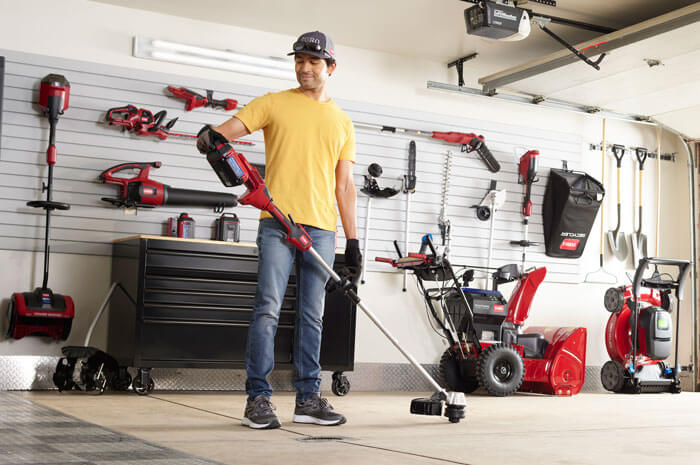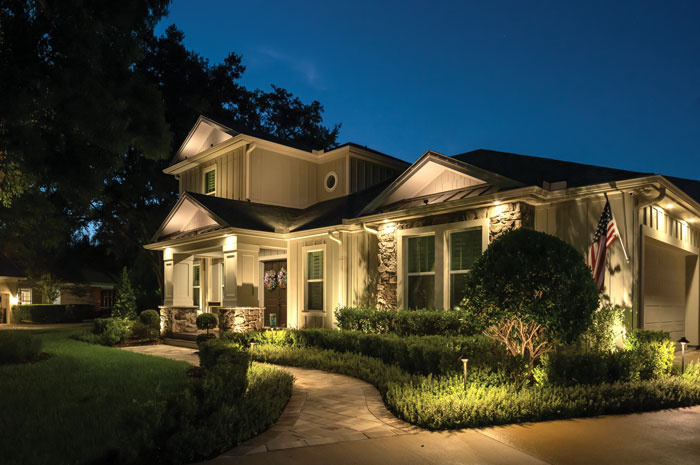
In recent years, battery-powered lawn tools have sky-rocketed in popularity as well as quality. With battery power and run-time increasing, it’s becoming increasingly easy to find electric tools that can do everything gas-powered tools can.
Here’s the thing: deciding on which battery-powered lawn mower or string trimmer can be a confusing choice. There are a lot of questions to consider. What do you need to know about the battery? What’s the difference between a brushed and a brushless motor?
When it comes to buying battery-powered lawn tools, it may be hard to truly understand how powerful they are. So, what do you really need to care about when comparing tools? Make sure you’re buying the right tool for the job by understanding the 10 basic aspects of battery-powered lawn tool performance.
1. What’s the Difference between Brushed and Brushless DC Motors?
Just when you thought your battery-powered mower shopping process was going to be easy, you spotted it. Brushed versus brushless lawn mowers. Brushed motor? Brushless? What does that even mean?
The answer is simpler than you might think. A brushed DC motor has coils in its center that rotate around permanent magnets. On the other hand, the brushless motor parts are switched. Their magnet is in the center while the coils circle around it.
But wait, how does this information help you make a decision? Don’t panic! The practical differences between the two motors are relatively simple:
Brushed Motors
Brushed DC motors are the traditional choice to power all sorts of battery-powered lawn tools. They are typically less expensive since producing brushed motors is simpler than its brushless counterpart. A brushed motor will be sufficient for most jobs.
If you’re comparing brushless versus brushed lawn mowers, there are other advantages of a brushless motor such as more torque at startup and more efficient speed control so you can expect better performance. However, brushed DC motors are usually chosen because of their price point. Typically, a brushed motor is less expensive than brushless.
Brushless DC Motors
Brushless DC motors use less power, have a longer run time, and don’t have any brushes that might need replacing over time. While the upfront cost may be higher, the increased efficiency, optimized performance, and longer life in your tools may make up the difference over time.
Check out the Toro 60V MAX* Flex-Force platform to see a range of brushless motor options. Including a string trimmer, blower, and chainsaw that are available with brushless DC motors, this selection of high-quality battery-powered lawn tools will give you that extra power and run time when you need it.
How Many Watts Does The Battery-Powered Lawn Tool Have?
While most people are looking for the voltage on most electric tools, the true measure of power is the wattage. To calculate the wattage, multiply the volts and the amperage.
For instance: Toro’s 60V MAX* 2.5Ah lithium-ion battery provides a baseline of 54 volts multiplied by 2.5 amp-hours, which is about 135 watt-hours.
Know Your Batteries
Say you’re in the market for a battery-powered hedge trimmer. If you want to know how long it will run for and how long it’ll take to charge, you have to learn a little about it’s power source! Getting to know the batteries that power your lawn tool is an important part of the purchasing process. To make things simple, we’ve broken down important terms below.
- Amp-Hours (Ah): Batteries are rated in amp-hours. Think of an amp-hour rating as the size of your gas tank. For instance, a 5 amp-hour battery can discharge 5 amps continuously for one hour. Conversely, 2.5 Ah battery will do half the work of a 5 Ah pack.
- Watt-Hours: When comparing tools, also look at a battery’s watt-hour calculation. Watt-hours generally can help provide an idea of how much total power a tool can deliver overall.
Estimated Battery-Powered Lawn Tool Run-Time
The best electric yard tools are ones that don’t need to be charged in the middle of a job. Run-time varies by tool and the job you are doing. If you want to keep a close eye on your battery and avoid running out of power mid-job, you’ll want to look for an onboard power meter that shows how much power is remaining as featured on Toro’s Flex-Force batteries.
It’s important to note that revving up speed can heavily impact your run time. If you’re taking on a large yard with your battery operated mower, slow and steady is the name of the game.
Speed Settings
- Variable Speed: Variable speed tools are, as you would expect, variable in speed. Generally, in battery products, they are infinitely variable. This gives you the ability to finely control the power of the tool. However, in some tools, this may be a nuisance, so some products offer a “throttle lock” like cruise control.
- Multi-Speed: Some products have 2 or 3-speed switches.
- Boost Mode: Products offering a “boost” mode generally require you to hold the button down for continuous high output. These boost buttons are used mostly for stubborn chores that need a little extra power. Running in boost mode the whole time will deplete the battery much faster.
Battery-Powered Lawn Tool Functions
Some lawn tools settings that allow for multiple functions. For instance,Toro’s 60V Attachment Capable Trimmer allows you to use the same power head to power multiple attachments including a string trimmer, hedge trimmer, pole saw, and more.
All variations of cordless trimmer from Toro feature a brushless motor, ensuring that the motor keeps going season after season. After all, endurance is the best function any lawn-enthusiast could ask for!
Snow and Leaf Blower Power Measurements
If you’re interested in purchasing a battery-powered blower, you might be reading a lot of different units of measurement when deciphering just how powerful the blower is. Here’s a list of the different terms and what they mean.
- MPH or miles per hour especially applies to Battery-powered blowers. The MPH refers to the rate at which it can move air through the nozzle. While it’s a handy measurement, it’s not a good measurement of power alone.
- CFM or cubic feet per minute is another unit of measurement that refers to how much air is blowing through the nozzle opening.
- Air horsepower can be thought of as general force — it is the combination of CFM (volume) and MPH (speed), which is the measurement of the amount of work the blower’s airstream can do.
Learn More About Battery-Powered Lawn Tools
Check out The Family Handyman for their tips on buying battery-powered tools for your yard. Or, learn more about each of the lithium-ion battery-powered lawn tools in Toro’s 60V Battery Flex-Force family. If you’re looking for the best electric lawn tools, you may also like our Tools for Good Lawn Care article for a full breakdown on all the tools both electric and manual that landscaper experts rely on.



